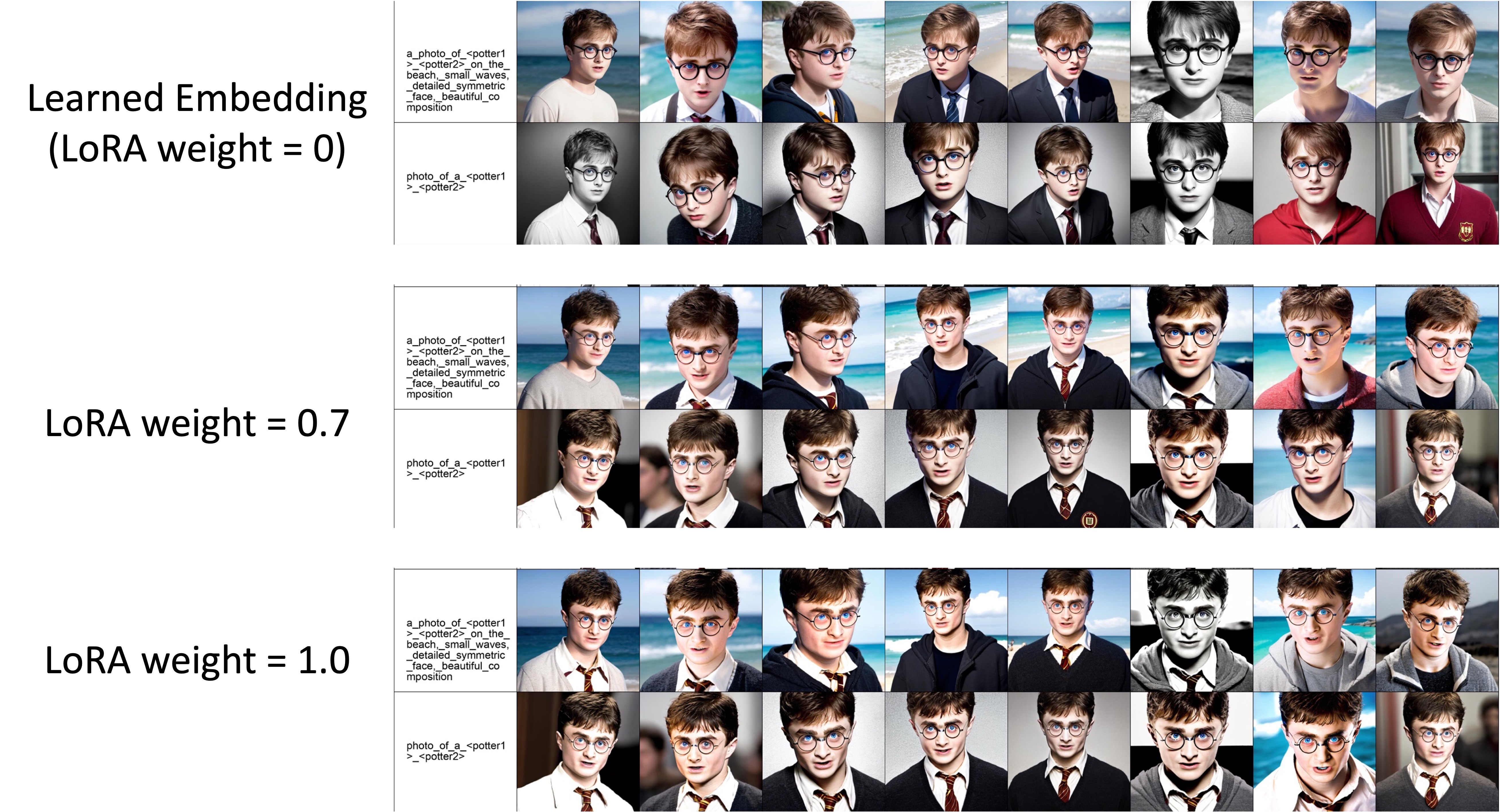🚩🚩🚩: Main branch for community has been released (keep updating the main branch).
Official codes for Mix-of-Show. This branch is for application, including simplified codes, memory/speed optimization and performance improvement. For research purpose, please refer to original research branch (paper results, evaluation, and comparison methods).
[NeurIPS 2023]- Mix-of-Show: Decentralized Low-Rank Adaptation for Multi-Concept Customization of Diffusion Models
Yuchao Gu, Xintao Wang, Jay Zhangjie Wu, Yunjun Shi, Yunpeng Chen, Zihan Fan, Wuyou Xiao, Rui Zhao, Shuning Chang, Weijia Wu, Yixiao Ge, Ying Shan, Mike Zheng Shou
Difference from LoRA:
-
In ED-LoRA, the embedding (LoRA weight=0) already encodes stable identity (use harry potter as example):
-
Based on the ED-LoRA, we can support multi-concept fusion without much identity loss.
Concept List:
Anime Character:
Real Character:
- StableDiffusion XL support.
- Colab Demo.
- Oct. 8, 2023. Add Attention Reg & Quality Improvement.
- Oct. 3, 2023. Release Main Branch for Community.
- Jun. 12, 2023. Research Code Released. Please switch to research branch.
- Python >= 3.9 (Recommend to use Anaconda or Miniconda)
- Diffusers==0.19.3
- XFormer (is recommend to save memory)
We adopt the ChilloutMix for real-world concepts, and Anything-v4 for anime concepts.
git clone https://github.com/TencentARC/Mix-of-Show.git
cd experiments/pretrained_models
# Diffusers-version ChilloutMix
git-lfs clone https://huggingface.co/windwhinny/chilloutmix.git
# Diffusers-version Anything-v4
git-lfs clone https://huggingface.co/andite/anything-v4.0.gitNote: Data selection and tagging are important in single-concept tuning. We strongly recommend checking the data processing in sd-scripts. In our ED-LoRA, we do not require any regularization dataset. The detailed dataset preparation steps can refer to Dataset.md. Our preprocessed data used in this repo is available at Google Drive.
Before tuning, it is essential to specify the data paths and adjust certain hyperparameters in the corresponding config file. Followings are some basic config settings to be modified.
datasets:
train:
# Concept data config
concept_list: datasets/data_cfgs/edlora/single-concept/characters/anime/hina_amano.json
replace_mapping:
<TOK>: <hina1> <hina2> # concept new token
val_vis:
# Validation prompt for visualization during tuning
prompts: datasets/validation_prompts/single-concept/characters/test_girl.txt
replace_mapping:
<TOK>: <hina1> <hina2> # Concept new token
models:
enable_edlora: true # true means ED-LoRA, false means vallina LoRA
new_concept_token: <hina1>+<hina2> # Concept new token, use "+" to connect
initializer_token: <rand-0.013>+girl
# Init token, only need to revise the later one based on the semantic category of given concept
val:
val_during_save: true # When saving checkpoint, visualize sample results.
compose_visualize: true # Compose all samples into a large grid figure for visualizationWe tune each concept with 2 A100 GPU. Similar to LoRA, community user can enable gradient accumulation, xformer, gradient checkpoint for tuning on one GPU.
accelerate launch train_edlora.py -opt options/train/EDLoRA/real/8101_EDLoRA_potter_Cmix_B4_Repeat500.ymlDownload our trained model from Google Drive.
Direct sample image:
import torch
from diffusers import DPMSolverMultistepScheduler
from mixofshow.pipelines.pipeline_edlora import EDLoRAPipeline, StableDiffusionPipeline
from mixofshow.utils.convert_edlora_to_diffusers import convert_edlora
pretrained_model_path = 'experiments/pretrained_models/chilloutmix'
lora_model_path = 'experiments/2002_EDLoRA_hermione_Cmix_B4_Iter1K/models/checkpoint-latest/edlora.pth'
enable_edlora = True # True for edlora, False for lora
pipeclass = EDLoRAPipeline if enable_edlora else StableDiffusionPipeline
pipe = pipeclass.from_pretrained(pretrained_model_path, scheduler=DPMSolverMultistepScheduler.from_pretrained(pretrained_model_path, subfolder='scheduler'), torch_dtype=torch.float16).to('cuda')
pipe, new_concept_cfg = convert_edlora(pipe, torch.load(lora_model_path), enable_edlora=enable_edlora, alpha=0.7)
pipe.set_new_concept_cfg(new_concept_cfg)
TOK = '<hermione1> <hermione2>' # the TOK is the concept name when training lora/edlora
prompt = f'a {TOK} in front of eiffel tower, 4K, high quality, high resolution'
negative_prompt = 'longbody, lowres, bad anatomy, bad hands, missing fingers, extra digit, fewer digits, cropped, worst quality, low quality'
image = pipe(prompt, negative_prompt=negative_prompt, height=768, width=512, num_inference_steps=50, guidance_scale=7.5).images[0]
image.save('res.jpg')Or sampling image grids for comprehensive visualization: specify the model path in test config, and run following command.
python test_edlora.py -opt options/test/EDLoRA/human/8101_EDLoRA_potter_Cmix_B4_Repeat500.ymlCollect all concept models you want to extend the pretrained model and modify the config in datasets/data_cfgs/MixofShow/multi-concept/real/* accordingly.
[
{
"lora_path": "experiments/EDLoRA_Models/Base_Chilloutmix/characters/edlora_potter.pth", # ED-LoRA path
"unet_alpha": 1.0, # usually use full identity = 1.0
"text_encoder_alpha": 1.0, # usually use full identity = 1.0
"concept_name": "<potter1> <potter2>" # new concept token
},
{
"lora_path": "experiments/EDLoRA_Models/Base_Chilloutmix/characters/edlora_hermione.pth",
"unet_alpha": 1.0,
"text_encoder_alpha": 1.0,
"concept_name": "<hermione1> <hermione2>"
},
... # keep adding new concepts for extending the pretrained models
]bash fuse.shDownload our fused model from Google Drive.
Single-concept sampling from fused model:
import json
import os
import torch
from diffusers import DPMSolverMultistepScheduler
from mixofshow.pipelines.pipeline_edlora import EDLoRAPipeline
pretrained_model_path = 'experiments/composed_edlora/chilloutmix/potter+hermione+thanos_chilloutmix/combined_model_base'
enable_edlora = True # True for edlora, False for lora
pipe = EDLoRAPipeline.from_pretrained(pretrained_model_path, scheduler=DPMSolverMultistepScheduler.from_pretrained(pretrained_model_path, subfolder='scheduler'), torch_dtype=torch.float16).to('cuda')
with open(f'{pretrained_model_path}/new_concept_cfg.json', 'r') as fr:
new_concept_cfg = json.load(fr)
pipe.set_new_concept_cfg(new_concept_cfg)
TOK = '<thanos1> <thanos2>' # the TOK is the concept name when training lora/edlora
prompt = f'a {TOK} in front of mount fuji'
negative_prompt = 'longbody, lowres, bad anatomy, bad hands, missing fingers, extra digit, fewer digits, cropped, worst quality, low quality'
image = pipe(prompt, negative_prompt=negative_prompt, height=1024, width=512, num_inference_steps=50, generator=torch.Generator('cuda').manual_seed(1), guidance_scale=7.5).images[0]
image.save(f'res.jpg')Regionally controllable multi-concept sampling:
bash regionally_sample.shThis project is released under the Apache 2.0 license.
This codebase builds on diffusers. Thanks for open-sourcing! Besides, we acknowledge following amazing open-sourcing projects:
-
LoRA for Diffusion Models (https://github.com/cloneofsimo/lora, https://github.com/kohya-ss/sd-scripts).
-
Custom Diffusion (https://github.com/adobe-research/custom-diffusion).
-
T2I-Adapter (https://github.com/TencentARC/T2I-Adapter).
@article{gu2023mixofshow,
title={Mix-of-Show: Decentralized Low-Rank Adaptation for Multi-Concept Customization of Diffusion Models},
author={Gu, Yuchao and Wang, Xintao and Wu, Jay Zhangjie and Shi, Yujun and Chen Yunpeng and Fan, Zihan and Xiao, Wuyou and Zhao, Rui and Chang, Shuning and Wu, Weijia and Ge, Yixiao and Shan Ying and Shou, Mike Zheng},
journal={arXiv preprint arXiv:2305.18292},
year={2023}
}If you have any questions and improvement suggestions, please email Yuchao Gu (yuchaogu9710@gmail.com), or open an issue.





